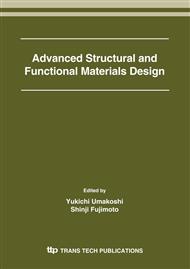p.301
p.305
p.309
p.313
p.319
p.325
p.331
p.337
p.343
Design of Lubricants Using Waste Slag in Large Strain Addition Strip Processing for Ultrafine-Grained Steels
Abstract:
Aiming to design new lubricants in the large strain addition strip process for ultrafine-grained steels, we tested the possibility of using waste slag, which is generated largely from iron and steelmaking processes, municipal waste treatments and so on. We then focused our attention on the slag containing water as the new lubricant. Slag satisfies the requirement of biting the workpiece stably, which cannot be achieved with conventional lubricants, because slag is stable as a solid phase of high hardness at the biting temperature in the strip process (100~200oC). In addition, slag contains water under hydrothermal conditions to provide lubricating effects by lowering glass transition temperature. In the present study, the effect of additive components (Al2O3, B2O3, CaO, MgO, K2O, Li2O and V2O5) on the glass transition temperature of a SiO2-Na2O-based slag containing water was examined. The glass transition temperature of the slag containing water is 150~300 oC, which is lower than that of original slag. It was also found that the glass transition temperature depends on the additive components to the slag.
Info:
Periodical:
Pages:
319-324
Citation:
Online since:
April 2006
Authors:
Price:
Сopyright:
© 2006 Trans Tech Publications Ltd. All Rights Reserved
Share:
Citation:


